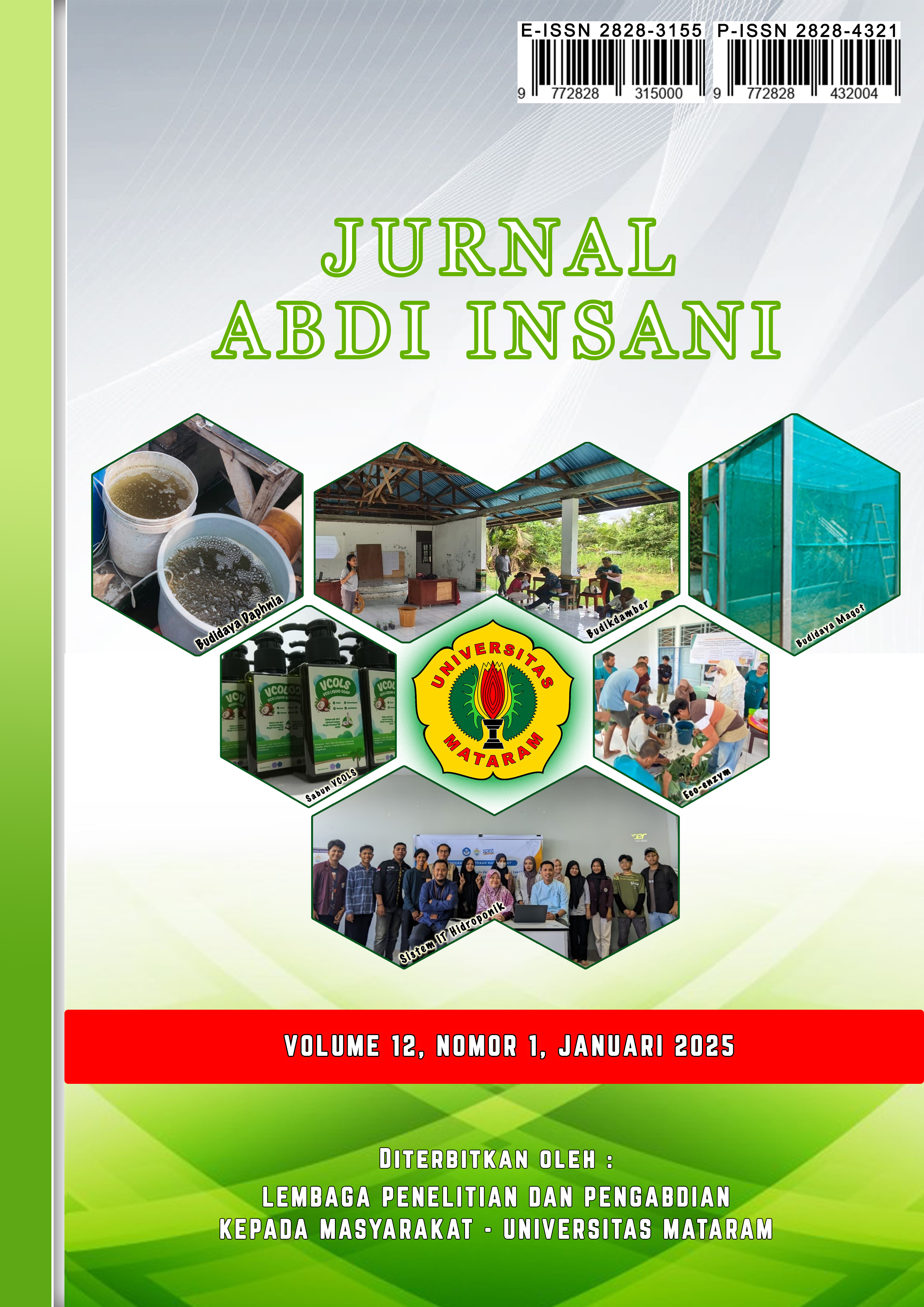INOVASI TEKNOLOGI PIROLISIS UNTUK PENINGKATAN KESEJAHTERAAN PETANI KOPI HUTAN DI DESA KRETEK BONDOWOSO
DOI:
https://doi.org/10.29303/abdiinsani.v12i1.2219Keywords:
waste, coffee husk, liquid smoke, biochar, KTH SejahteraAbstract
The Sejahtera Forest Farmers Group (KTH) was established to improve the welfare of the community in Kretek Village, Taman Krocok Subdistrict, Bondowoso Regency. This KTH manages robusta coffee plantations with an annual yield of 500-800 kg. However, for 11 years, the land has not been fertilized, resulting in decreased soil productivity and coffee bean quality. To address this issue, pyrolysis technology was introduced to utilize coffee husk waste. This technology produces biochar, which can enhance soil fertility, bind pollutants, and reduce greenhouse gas emissions. It also produces liquid smoke that can be used as an antimicrobial agent and food preservative. The goal of this activity is to help the community turn coffee husk waste into a valuable product. The method used is participatory rural appraisal, which includes introducing innovations to process coffee husk waste into biochar and liquid smoke, designing and building the equipment, and conducting hands-on practice involving the Sejahtera KTH members. The results of this community service activity show an increase in the knowledge and skills of forest farmers in making biochar and liquid smoke using pyrolysis technology, from 30% to 90%. Overall, this community service program has fostered enthusiasm for utilizing coffee husk waste and enhanced the cohesion of the Sejahtera KTH.
Downloads
References
Afrah, B. D., Riady, M. I., Sari, T. I., Hadiah, F., Sumardi, N., Pratiwi, S. I., Julianto, A., & Aryansyah, A. D. (2023). Produksi Asap Cair dari Limbah Kopi di Desa Karang Tanding Kecamatan Jarai Kabupaten Lahat. Aksiologiya: Jurnal Pengabdian Kepada Masyarakat, 7(3). https://doi.org/10.30651/aks.v7i3.9101
BPS (2023). Produksi Perkebunan Karet dan Kopi Menurut Kabupaten/Kota dan Jenis Tanaman di Provinsi Jawa Timur (Ton), 2021 dan 2022. https://jatim.bps.go.id/id/statistics-table/1/MjYwMSMx/produksi-perkebunan-karet-dan-kopi-menurut-kabupaten-kota-dan-jenis-tanaman-di-provinsi-jawa-timur--ton---2021-dan-2022.html
Budaraga, I. K., & Putra, D. P. (2019). Liquid Smoke Antimicrobial Test of Cocoa Fruit Peel Against Eschericia Coli and Staphylococcus Aureus Bacteria. IOP Conference Series: Earth and Environmental Science, 365(1), 012049. https://doi.org/10.1088/1755-1315/365/1/012049
Czernik, S., & Bridgwater, A. V. (2004). Overview of Applications of Biomass Fast Pyrolysis Oil. Energy & Fuels, 18(2), 590–598. https://doi.org/10.1021/ef034067u
Dewi, F. C., Tuhuteru, S., Aladin, A., & Yani, D. S. (2021). Characteristics of Liquid Smoke of Red Fruit (Pandanus conoideus. L.) Waste with Pyrolysis Method and Potentially as Biopesticide. Journal of Environmental and Agricultural Studies, 2(2), 81–86. https://doi.org/10.32996/jeas.2021.2.2.7
Erdiansyah, I., Soelaksini, L. D., Pratiwi, B. Y., Eliyatiningsih, E., Maulana, A. J. Y., & Febyanti, N. P. E. S. (2024). Edukasi Pembuatan Teknologi Asap Cair Sebagai Pengendali Hama Wereng Pada Budidaya Padi. Journal of Community Development, 5(2), 267–274. https://doi.org/10.47134/comdev.v5i2.270
Keryanti, Permanasari, A. R., Yulistiani, F., Sihombing, R. P., & Wibisono, W. (2020). Applications of Liquid Smoke from Biomass on Food Products: A Review: Proceedings of the International Seminar of Science and Applied Technology (ISSAT 2020). International Seminar of Science and Applied Technology (ISSAT 2020), Bandung, Indonesia. https://doi.org/10.2991/aer.k.201221.086
Nguyen, D. V., Duong, C. T. T., Vu, C. N. M., Nguyen, H. M., Pham, T. T., Tran-Thuy, T.-M., & Nguyen, L. Q. (2023). Data on chemical composition of coffee husks and lignin microparticles as their extracted product. Data in Brief, 51, 109781. https://doi.org/10.1016/j.dib.2023.109781
Passos, F., Cordeiro, P. H. M., Baeta, B. E. L., De Aquino, S. F., & Perez-Elvira, S. I. (2018). Anaerobic co-digestion of coffee husks and microalgal biomass after thermal hydrolysis. Bioresource Technology, 253, 49–54. https://doi.org/10.1016/j.biortech.2017.12.071
Rocher-Ros, G., Stanley, E. H., Loken, L. C., Casson, N. J., Raymond, P. A., Liu, S., Amatulli, G., & Sponseller, R. A. (2023). Global methane emissions from rivers and streams. Nature, 621(7979), 530–535. https://doi.org/10.1038/s41586-023-06344-6
Ton, S., Priyadi, D. A., & Darma, Y. Y. (2020). Pembuatan Asap Cair Guna Mendukung Pertanian Organik di Desa Bulusari, Kecamatan Kalipuro, Kabupaten Banyuwangi. Jurnal Pengabdian kepada Masyarakat (Indonesian Journal of Community Engagement), 6(4). https://doi.org/10.22146/jpkm.51793
Triawan, D. A., Banon, C., Saputra, H. E., Nurwidiyani, R., Adfa, M., & Andina, K. F. (2022). Pendampingan Pembuatan Asap Cair dari Sekam dan Jerami Padi pada Kelompok Tani Akur Kabupaten Rejang Lebong. Wikrama Parahita : Jurnal Pengabdian Masyarakat, 6(1), 67–72. https://doi.org/10.30656/jpmwp.v6i1.3747
Wang, J., & Wang, S. (2019). Preparation, modification and environmental application of biochar: A review. Journal of Cleaner Production, 227, 1002–1022. https://doi.org/10.1016/j.jclepro.2019.04.282
Weber, K., & Quicker, P. (2018). Properties of biochar. Fuel, 217, 240–261. https://doi.org/10.1016/j.fuel.2017.12.054
Wijaya, M., Wiharto, M., & Danial, M. (2019). Using pine and cocoa waste with pyrolysis technology by liquid smoke, charcoal and bio char. Journal of Physics: Conference Series, 1321(2), 022031. https://doi.org/10.1088/1742-6596/1321/2/022031




















